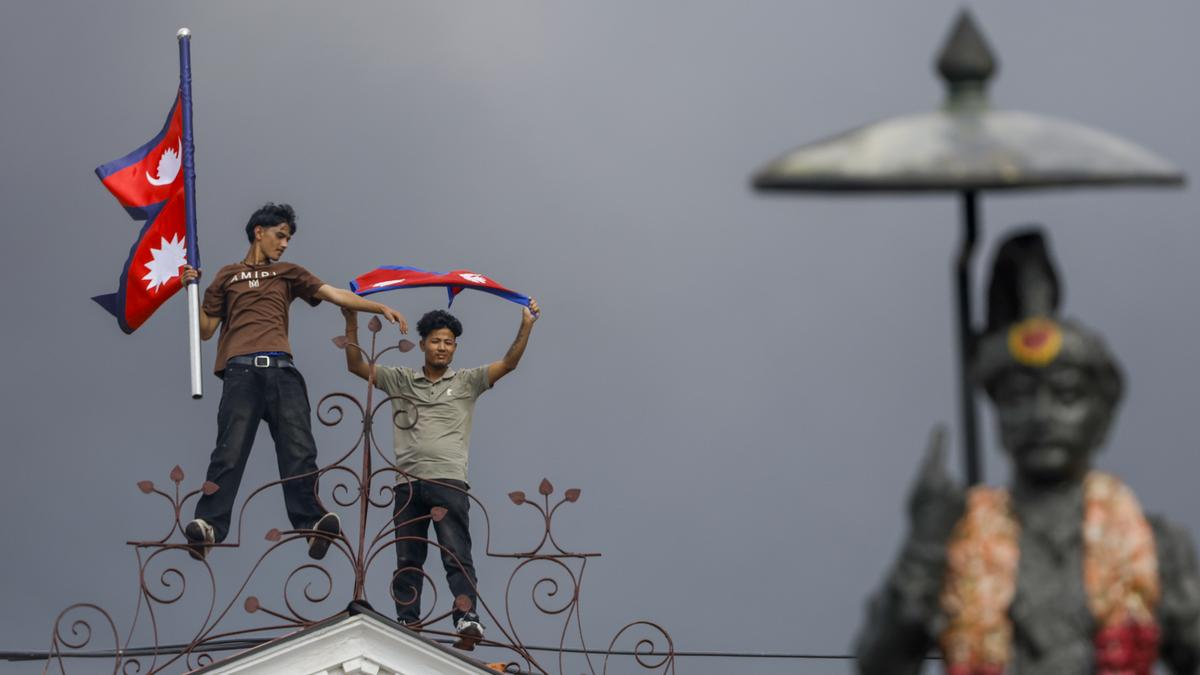The “Gen Z” protests in Nepal that began as a movement against the ban on social media outlets and corruption on Monday, took a violent turn the next day, with attacks on all institutions. The proximate reasons apart, political instability — marked by frequent changes in government and unethical alliances — has kept Nepal’s stark societal inequalities intact, especially among youth who are forced to emigrate due to soaring unemployment. This should explain their angry protests.
When Khadga Prasad Oli — he has since resigned — formed a new government in 2024, it marked the 30th change in leadership in Nepal ever since it became an elected democracy in 1990. Despite transitioning from constitutional monarchy (1990-2008) to becoming a constitutional republic (2008 onwards), no Prime Minister has ever completed a full term, making Nepal one of the most politically unstable democracies.
Data show that Nepal tops the world in government tenures since 1990. Excluding countries such as San Marino, Bosnia-Herzegovina and Switzerland, where frequent leadership changes are legally mandated, Nepal leads with 25 completed tenures since 1990—each lasting on average just a year and two months. The table lists top countries in terms of number of tenures of heads of governments between 1990 and August 2021
This count excludes two periods of direct rule by former king Gyanendra and tenures after August 2021, beyond which comparable data are unavailable.
These frequent changes have undermined the promise of stable, democratic, federal governance as envisioned by Nepal’s two Jan Andolans (1989-90 and 2005-2008). Political instability has also meant that long-standing inequalities — between rich and poor, rural and urban, educated and less-educated — remain entrenched. These divides are most pronounced among youth, the main cohort that led the demonstrations against political elites in protests described as “Gen Z vs Nepo kids,” with the former demanding accountability while directing anger at the latter.
Nepal’s overall unemployment rate stood at 12.5% in 2022-23, but the burden falls disproportionately on the young. Among those aged 15-24, unemployment reached 22.7%, compared to 11.5% in the 25-44 group and 7.5% among those aged 45-64. The below chart shows the Nepal’s age-wise unemployment rate in 2022-23 (in %).
Inequality cuts across multiple dimensions. Some 17.2% of individuals from the poorest households were unemployed, as against 8.5% from the richest. Education creates stark differences: unemployment stands at 18.1% among those with only basic schooling, compared to just 6.3% among bachelor’s degree holders. Geography adds another layer — while Kathmandu valley records the lowest rate at 7.6%, unemployment exceeds 20% in many rural regions.
Critically, labour force participation itself is much lower among poor, rural, and less-educated populations. Among the relatively fewer in these groups who enter the labour market, a higher share cannot find work. This creates a double disadvantage — not only are they unable to find employment, but many are not even actively seeking it due to lack of relevant opportunities.
This has pushed many, especially from disadvantaged groups, to seek work abroad. About one in four males in Nepal is absent from home, with a significant share living outside the country. The proportion of female-headed households has increased dramatically from just 13.6% in 1995-96 to 37.1% in 2022-23, reinforcing this pattern of male out-migration.
Absenteeism is starkest in rural areas and among youth. About 20% of the rural population is absent from home, compared with just 8.7% in the Kathmandu valley. More than half of male absentees (56%) are aged 15-29 years—the same group recording the highest unemployment rate.
Those who leave Nepal to work abroad have become a major income source for families and the nation. The share of households receiving remittances has risen sharply from 23.4% in 1995-96 to 76.8% in 2022-23. Among such households, remittances now account for over 33% of total income, up from 26.6% in 1995-96. So remittance-dependent households have not only become more widespread but also increasingly reliant on this income. The below chart shows the share of households receiving remittances and the share of remittances in the total income of recipient households in Nepal.
More significantly, remittances increasingly originate from outside Nepal. In 2022-23, nearly 50% came from countries other than India, about 20% from India, and the rest from internal migrants. In contrast, in 1995-96, 44.7% came from within Nepal and 33% from India. This shift highlights both the growing exodus of Nepali workers and diversification of destinations beyond India. Current remittance sources show that Qatar (10%), Saudi Arabia (9%), Malaysia (8.6%), and the UAE (7.1%) are the most preferred non-Indian destinations for Nepali workers.
Personal remittances have surged from just 1% of Nepal’s GDP in 1990 to over 33% in 2024. By this measure, Nepal ranks as the world’s fourth most remittance-dependent country, behind Lebanon, Tajikistan, and Tonga. Notably, this World Bank figure covers only cross-border remittances and excludes internal transfers, underscoring out-migration’s critical role in Nepal’s economy. The chart below shows the personal remittances, received as a % of GDP in Nepal overtime.
These statistics show precisely why Nepal’s youth had taken to the streets with such fury, even if the violent upheaval that followed the Gen Z’s protests the next day deserves a closer look at who instigated the arson and vandalism that targeted Parliament, the Supreme Court besides other institutions.
In sum, Nepal has achieved the world’s highest level of political instability while simultaneously becoming the world’s fourth most-remittance-dependent economy. These two facts seen together suggest that political instability has resulted in the lack of economic policies to diversify Nepal’s economy and provide jobs, forcing citizens to seek jobs abroad. Which goes on to explain why there is a severe anger against the political system that came into being after two massive civil and political society mobilisations in 1990 and 2005.
With inputs from Godhashri S.
Published – September 11, 2025 07:00 am IST
